June 21, 2021 feature
A cavitation-on-a-chip device with a multiple microchannel configuration
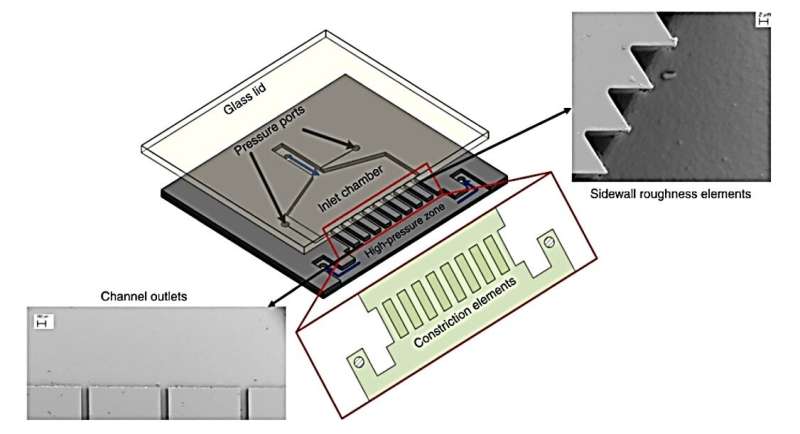
Hydrodynamic cavitation is a major phase change phenomena that can occur with a sudden decrease in the local static pressure within a fluid. The emergence of microelectromechanical systems (MEMS) and high-speed microfluidic devices have attracted considerable attention with implementations in many fields including cavitation applications. In a new study now on Nature: Microsystems and Nanoengineering, Farzad Rokhsar Talabazar and colleagues in Istanbul Turkey, Sweden and Switzerland proposed a new generation of cavitation-on-a-chip devices with eight parallel structured microchannels. The team used water and a poly vinyl alcohol (PVA) microbubble suspension as the working fluids in the device. The features of the next-generation cavitation-on-a-chip instrument have applications across microfluidic or organ-on-a-chip devices for integrated drug release and tissue-engineering applications.
Hydrodynamic cavitation
Hydrodynamic cavitation (HC) is a phase-change phenomenon that involves a liquid and begins when the static pressure drops to a critical value known as the saturation vapor pressure. The phenomenon includes progressive vaporization for the generation, growth and implosion of bubbles. For example, small bubbles can form in low-pressure zones, typically at the entrance of a flow restrictive element where inertial cavitation bubbles can grow in a successive cycle until they reach a high-pressure area. Cavitation is an undesirable phenomenon and most studies on the physics of cavitation aim to prevent or decrease it. Researchers aim to design and fabricate microfluidic devices capable of generating cavitation bubbles. In this work, Talabazar et al. determined the practicality of the cavitation-on-a-chip concept to generate cavitating flows at lower upstream pressures, to explore their capability for microsystem applications. For this purpose, Talabazar et al. designed a new microfluidic device with eight short, parallel micro-channels as a next-generation cavitation-on-a-chip device. They noted the effect of polyvinyl alcohol (PVA) microbubbles as a cavitation facilitator on cavitation inception and development. The results proved the high performance of the device for cavitation inception and emerging applications.
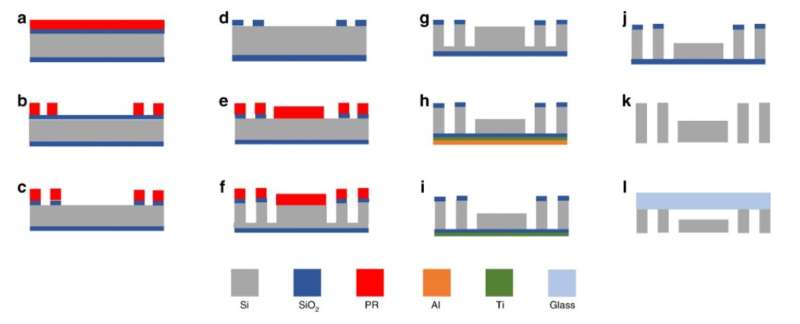
Design and configuration of the microfluidic device
The team incorporated a microdevice with parallel flow restrictive elements where the microfluidic device contained an inlet channel for fluid guidance into the inlet chamber. The inlet chamber contained a long section to allow transient chaotic flow to disappear before the fluid entered the nozzle area. The team supplied the desired inlet pressure to the system using a high-pressure nitrogen tank from the top of a steel liquid container. Then using an imaging system, they acquired images within very short time-intervals. During the experiments, Talabazar et al. used two working fluids with different inlet pressures from 0.2 to 1.1 MPa. The results highlighted a new generation cavitation-on-a-chip microfluidic device. The team made the device function with water and polyvinyl alcohol microbubble-water aliquots. The proof-of-concept study highlighted how the efficient multifunctional reactor can be explained in practice. The scientists described the cavitation process based on parameters measured from the mentioned open-loop experimental setup and attained developed sheet cavitating flow conditions at a lower Reynolds number under laminar flow conditions.
-
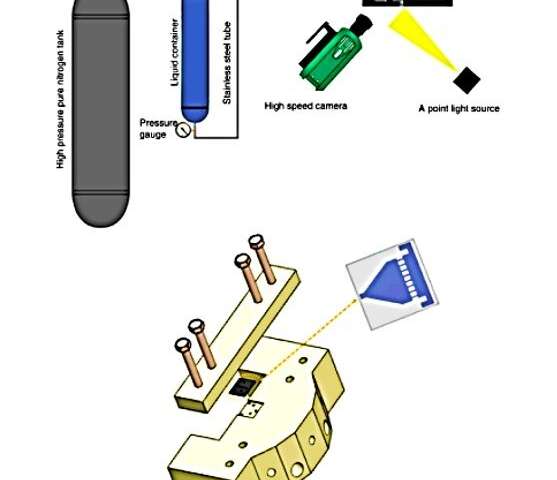
Hydrodynamic cavitation (HC) experimental setup. Visualizing cavitating flows and the package used to secure and seal the microfluidic device. Credit: Nature Microsystems & Nanoengineering, doi: 10.1038/s41378-021-00270-1 -
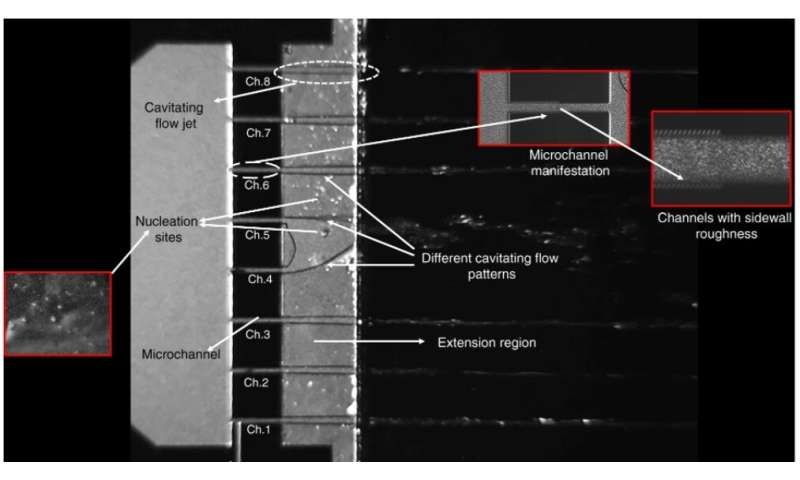
Overview of cavitation occurance. Different cavitating flow patterns have been formed inisde the multiple parallel microchannel configuration at Pi = 1.1 MPa. Credit: Nature Microsystems & Nanoengineering, doi: 10.1038/s41378-021-00270-1
Microbubble dynamics
When compared to the cavitation inception conditions, the cavitation flow conditions showed faster growth rates of microbubbles, where the microbubble size increased at high upstream pressures. The microbubbles could also expand beyond a critical radius, when compared to cavitation bubbles. Previous studies on ultrasound cavitation additionally reported that microbubbles reached maximum expansion at a peak negative transmission pressure to then undergo immediate compression. During hydrodynamic cavitation, microbubbles expanded with a sudden decrease in pressure to demonstrate the dynamics of microbubbles in the experimental setup; to demonstrate this, Talabazar et al. used the modified Rayleigh-Plesset equation. Notably, the microbubble shell property formed a major parameter to provide sufficient stiffness to prevent gas bubble dissolution. As a consequence, the team noted that the viscoelastic properties of polyvinyl alcohol microbubbles maintained a significant role to stabilize after hydrodynamic cavitation. The outcomes additionally revealed how the microbubble size played a dominant role for the inception and intensification of the cavitation process by providing more nucleation sites for bubble growth.
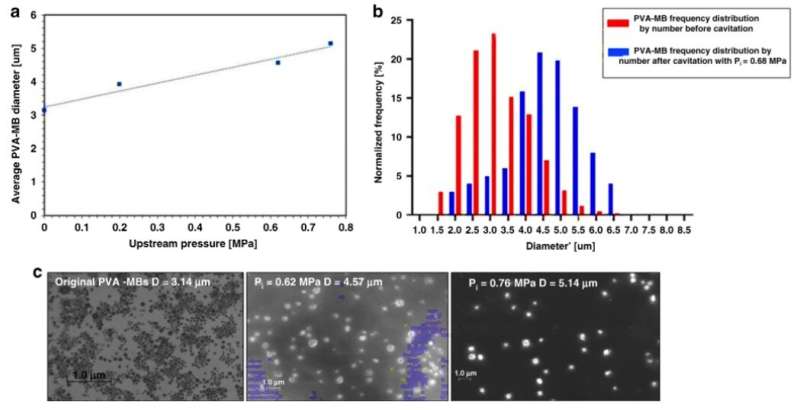
Outlook
In this way, Farzad Rokhsar Talabazar and colleagues devised a new generation 'cavitation-on-a-chip' device housing eight parallel structured short microchannels. The new design decreased the upstream pressure to initiate hydrodynamic cavitation. The proposed setup allowed the formation of diverse cavitating flow regimes at a constant upstream pressure in state-of-the-art devices. The described instrument can provide cavitating flow patterns with the same intensity at a lower input energy. The geometry of the device and its evolving cavitating flow regimes are faster and facile to existing microdevices.
The team used two working fluids—water and polyvinyl alcohol microbubble suspensions during the experiments, and the microbubbles provided more nucleation sites to facilitate inception at a significantly lower upstream pressure for the polyvinyl alcohol microbubbles compared to water. The emerging cavitating flows can develop faster and the proposed 'cavitation-on-a-chip' device has higher potential across multiple applications involving microfluidic devices for integrated drug release and tissue engineering applications.
More information: Talabazar F. R. et al. Design and fabrication of a vigorous "cavitation-on-a-chip" device with a multiple microchannel configuration, Microsystems & Nanoengineering, doi.org/10.1038/s41378-021-00270-1
Qiu X. et al. Liquid-phase exfoliation of graphite into graphene nanosheets in a hydrocavitating 'lab-on-a-chip', Royal Society of Chemistry, 10.1039/C8RA05976D
Brotchie A. et al. Effect of power and frequency on bubble-size distributions in acoustic cavitation., 10.1103/PhysRevLett.102.084302
© 2021 Science X Network





















